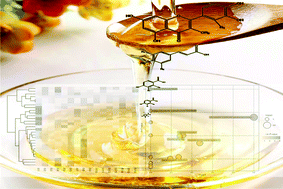Effects of honey-extracted polyphenols on serum antioxidant capacity and metabolic phenotype in rats†
Abstract
It is generally known that honey polyphenols have antioxidant capacity and numerous biological functions. However, their metabolic phenotype after digestion has not been studied. In this study, the effects of honey-extracted polyphenols (HEPs) on serum antioxidant capacity and metabolic phenotype were revealed for the first time. Herein, sixteen male Sprague-Dawley rats were randomly divided into two groups: one group was administered HEPs (200 mg per kilogram body weight dose) and the other group was fed distilled water three times. Then, 1 h after the last gavage, the metabolic profiling of serum was analyzed by UHPLC-Orbitrap-HRMS and multivariate statistical analysis, and the following results were obtained. At first, twenty-five metabolites, including polyphenols, unsaturated fatty acids, and amino acids, were selected as potential biomarkers. Then, metabolic pathway analysis showed that several amino acid metabolism pathways, ubiquinone and other terpenoid-quinone biosynthesis, arachidonic acid metabolism, nicotinate and nicotinamide metabolism, and inositol phosphate metabolism were affected. Association analysis demonstrated that the alteration of metabolites may be responsible for the increased serum antioxidant capacity. This new insight into the effects on the metabolic phenotype after HEP intake prompted the study on the biological functions and emerging health benefits of HEPs.



 Please wait while we load your content...
Please wait while we load your content...